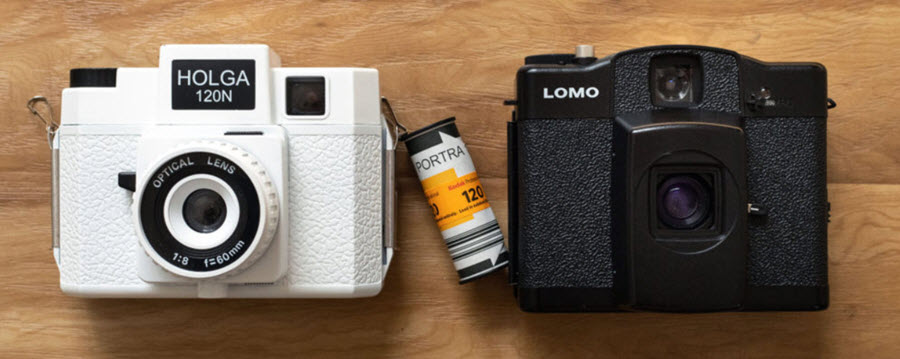Contents
The box camera Holga is a medium-format 120 film camera famous for its low-fidelity aesthetic. Invented in mainland China and later manufactured in Hong Kong, Holga maintains a cult-following among photographers attracted to Holga´s tendency to produce distorted and even surrealistic images with light leaks, blurring, vignetting, etcetera.
Holga cameras are used for a wide range of photography, including still lifes, portraits, landscape scenes, and street photography. Many Holga-fans state that lack of precision encourages them to explore innovation and creative vision.
Holga photographs have won numerous awards and prizes in the fields artistic photography and news photography.
Short facts about Holga
Released: 1982
Film format: 120
Film size: 56 mm × 56 mm (6×4.5 cm or 6×6 cm film format)
Shutter speed: 1/100 or 1/125, Bulb
Focus: Manual (four settings)
Lens: 60 mm plastic meniscus
F-numbers: f/8.0, f/11.0 (actual f/13 pre-2009)

History
The Holga camera was designed by Lee Ting-mo in China in the early 1980s, to be an affordable camera for ordinary working-class Chinese. Back then, 120 roll film in black-and-white was the most widely available film in mainland China, so the Holga was designed to work with that.
Fairly soon, however, the import of roll film from abroad (especially 35 mm film) made Chinese consumers lose interest in 120 roll film, so the camera manufactorer took the Holgas abroad, hoping to find new markets for them.
Outside mainland China, experimental photographers took a liking to the Holga for its ability to produce distorted images. In the 21st century, the same thing has happened within mainland China.
Lenses
Most Holga cameras use a simple single-piece plastic meniscus lens where the focal length is 60 mm. The zone-focus system can adjust from roughly 1 meter to infinity. Since it is a simple meniscus lens, you can expect soft focus and chromatic aberration.
Holga cameras where there is a G in the model name have a glass lens instead of a plastic one.
Modifications
- When the lens (or the entire shutter assembly) is replaced with a pinehole, the result is known as a “Pinholga”.
Accessories
- A fisheye lens is available. The result is circular fisheye images.
Aperture settings
The aperture setting switch have two positions: sunny and cloudy. The nominal effect is f/11 and f/8, respectively, but the switch doesn´t work on Holga cameras produced before 2009. The actual aperture for such cameras is always around f/13.
From 2009, the switch works, but is for f/13 and f/20.
Modifications
- The camera can be modified to provide larger or smaller aperture.
Film formats
The original Holga was made to accept either a 6 x 4.5 format or a 6 x 6 format. When it was discovered early on that the camera produced vignetting in the 6 x 6 format, all Holgas got their film-size switches fixed to the 6 x 4.5 format.
Holga owners who didn´t mind vignetting would remove the fix.
Later Holga cameras, such as the 120N are made to accept 6×4.5 and 6 x 6.
Modifications
Many Holgas have been modified to accept 35 mm film. Adapters are available for this purpose.
Accessories
Exposures
- 16 exposures per 120 roll in 6 x 4.5 format
- 12 exposured per 120 roll in 6 x 6 format
Shutter speed
There is only one shutter speed and it is approximately 1/100th of a second.
A few examples of popular modifications
- In a “flocked” Holga, the interior has been painted matte black to limit the impact of light from light leaks.
- When using panchromatic films, you can eliminate light leaks by blocking the red window on the back of the camera.
- The Holga camera can be fitted with a Polaroid back to make it compatible with Polaroid 80 series instant film. Newer models can also be adapted to Polaroid 100 series instant film, but the images will not be centred.The modification will make the viewfinder unusable.A Holga adapted in this fashion is known as a “Polga” or “Holgaroid”.
Examples of available accessories for Holga
- The Holgon Flash, a small normal flash
- The Holgon Strobe Flash
- The Holgon Slave Flash
- Cable release (for the shutter)
- Tripod mount
- Full negative 35 mm film adapter
- “Panoramic” 35 mm film adapter
- Special effects filters, such as colour filters and center spot filters
- Filter holders, for one or two filters
- Filters to place over the flash
This article was last updated on: October 5, 2020
